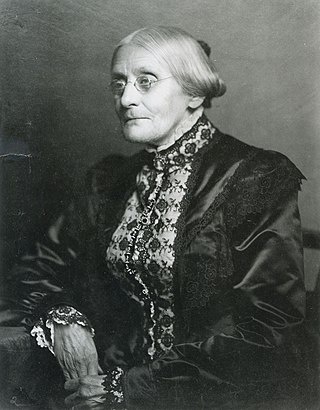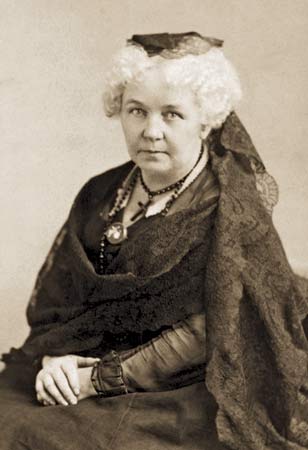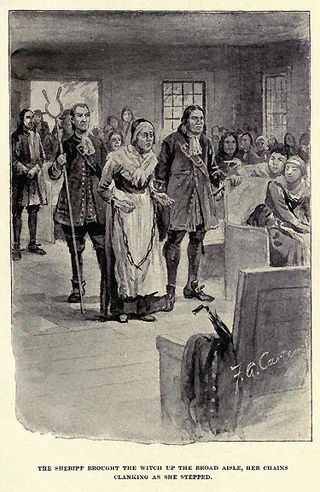Related Research Articles

Susan B. Anthony was an American social reformer and women's rights activist who played a pivotal role in the women's suffrage movement. Born into a Quaker family committed to social equality, she collected anti-slavery petitions at the age of 17. In 1856, she became the New York state agent for the American Anti-Slavery Society.

The Declaration of Sentiments, also known as the Declaration of Rights and Sentiments, is a document signed in 1848 by 68 women and 32 men—100 out of some 300 attendees at the first women's rights convention to be organized by women. Held in Seneca Falls, New York, the convention is now known as the Seneca Falls Convention. The principal author of the Declaration was Elizabeth Cady Stanton, who modeled it upon the United States Declaration of Independence. She was a key organizer of the convention along with Lucretia Coffin Mott, and Martha Coffin Wright.

Elizabeth Cady Stanton was an American writer and activist who was a leader of the women's rights movement in the U.S. during the mid- to late-19th century. She was the main force behind the 1848 Seneca Falls Convention, the first convention to be called for the sole purpose of discussing women's rights, and was the primary author of its Declaration of Sentiments. Her demand for women's right to vote generated a controversy at the convention but quickly became a central tenet of the women's movement. She was also active in other social reform activities, especially abolitionism.

Abigail Adams was the wife and closest advisor of John Adams, the second president of the United States, and the mother of John Quincy Adams, the sixth president of the United States. She was a founder of the United States, and was both the first second lady and second first lady of the United States, although such titles were not used at the time. She and Barbara Bush are the only two women in American history who were both married to a U.S. president and the mother of a U.S. president.

Lucy Stone was an American orator, abolitionist and suffragist who was a vocal advocate for and organizer of promoting rights for women. In 1847, Stone became the first woman from Massachusetts to earn a college degree. She spoke out for women's rights and against slavery. Stone was known for using her birth name after marriage, contrary to the custom of women taking their husband's surname.

Mary Ashton Livermore was an American journalist, abolitionist, and advocate of women's rights. Her printed volumes included: Thirty Years Too Late, first published in 1847 as a prize temperance tale, and republished in 1878; Pen Pictures; or, Sketches from Domestic Life; What Shall We Do with Our Daughters? Superfluous Women, and Other Lectures; and My Story of the War. A Woman's Narrative of Four Years' Personal Experience as Nurse in the Union Army, and in Relief Work at Home, in Hospitals, Camps and at the Front during the War of the Rebellion. She wrote a sketch of the sculptor Anne Whitney for Women of the Day and delivered the historical address for the Centennial Celebration of the First Settlement of the Northwestern States in Marietta, Ohio on July 15, 1788.
John Proctor was a landowner in the Massachusetts Bay Colony. He and his wife Elizabeth were tried and convicted of witchcraft as part of the Salem Witch Trials, whereupon he was hanged.
Elizabeth Proctor was convicted of witchcraft in the Salem Witch Trials of 1692. She was the wife of John Proctor, who was convicted and executed.

Paulina Wright Davis was an American abolitionist, suffragist, and educator. She was one of the founders of the New England Woman Suffrage Association.

Polly Berry was an African American woman notable for winning two freedom suits in St. Louis, one for herself, which she won in 1843, and one for her daughter Lucy, which she won in 1844. Having acquired the surnames of her slaveholders, she was also known as Polly Crockett and Polly Wash, the latter of which was the name used in her freedom suit.

Martha Coffin Wright was an American feminist, abolitionist, and signatory of the Declaration of Sentiments who was a close friend and supporter of Harriet Tubman.

Rebecca Nurse was a woman who was accused of witchcraft and executed by hanging in New England during the Salem Witch Trials of 1692. She was fully exonerated fewer than twenty years later.
The National Women's Rights Convention was an annual series of meetings that increased the visibility of the early women's rights movement in the United States. First held in 1850 in Worcester, Massachusetts, the National Women's Rights Convention combined both female and male leadership and attracted a wide base of support including temperance advocates and abolitionists. Speeches were given on the subjects of equal wages, expanded education and career opportunities, women's property rights, marriage reform, and temperance. Chief among the concerns discussed at the convention was the passage of laws that would give women the right to vote.

Freedom suits were lawsuits in the Thirteen Colonies and the United States filed by slaves against slaveholders to assert claims to freedom, often based on descent from a free maternal ancestor, or time held as a resident in a free state or territory.

Samuel Edmund Sewall (1799–1888) was an American lawyer, abolitionist, and suffragist. He co-founded the Massachusetts Anti-Slavery Society, lent his legal expertise to the Underground Railroad, and served a term in the Massachusetts Senate as a Free-Soiler.
Lady Anna Eliza Mary Gore-Langton, néeTemple-Nugent-Brydges-Chandos-Grenville was an English campaigner for women's rights.

Mary Jane Warfield Clay was an American socialite, suffragist, abolitionist, and political activist. An early leader in the suffrage movement in Kentucky, she began by forming a suffrage club at her home in 1879. Her experience and success as a farm manager included her acute business sense in the middle of the American Civil War. She sold supplies from her farm to both Union and Confederate forces when they each occupied the Commonwealth.
Thankful Southwick was an affluent Quaker abolitionist and women's rights activist in Boston, Massachusetts. Thankful was lifelong abolitionist who joined the Boston Female Anti-Slavery Society in 1835 with her three daughters. She was present at both the 1835 Boston Mob and the Abolition Riot of 1836. During the 1840 schism in the Boston Female Anti-Slavery Society, Thankful sided with the Westons, Chapmans, Childs, Sergeants, and other radical Garrisonians to reestablish the Boston Female Anti-Slavery Society. She also later joined the New England Non Resistance Society.
Elizabeth Jaquelin Ambler Brent Carrington also known as Betsy Ambler Carrington founded the Female Humane Association in Richmond, Virginia. It is now known as the Memorial Foundation for Children. Believed to be the first of its kind in Virginia, the organization provided safety and shelter to destitute girls and kept they from a life of poverty and the possibility of becoming prostitutes to survive.